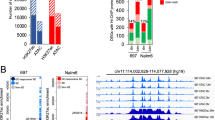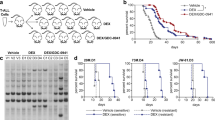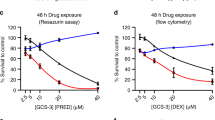Abstract
Transcription of the genes Granzyme A (GZMA), FK506 binding protein 51 (FKBP5), and Down syndrome critical region gene 1 (DSCR1) is upregulated in leukemic cells upon treatment with glucocorticoids (GCs). Several lines of evidence suggest that these genes are implicated in GC-induced apoptosis upstream of the Bcl-2 family of proteins. These genes were upregulated by GC even in the presence of an inhibitor of protein synthesis, cycloheximide, indicating that they are direct target genes of glucocorticoid receptors. DSCR1 is reported to have four isoforms, each of which has a distinct first exon, E1–E4. Among these isoforms, the one with E1 was selectively upregulated by GC. GZMA and FKBP5 have a cluster of putative glucocorticoid response elements (GREs) in introns 1 and 2, respectively, that was identified to be responsible for the response to GC. They were composed of one complete (A/T)G(A/T)(A/T)C(A/T) sequence surrounded by two incomplete (A/T)G(A/T)(A/T)C(A/T) sequences separated by one to four nucleotides. DSCR1, however, did not have a functional GRE upstream or downstream of exon 1. These studies may lead to improved therapeutic uses of GCs in leukemia and lymphoma based upon the expression of these GC target genes.
This is a preview of subscription content, access via your institution
Access options
Subscribe to this journal
Receive 12 print issues and online access
$259.00 per year
only $21.58 per issue
Buy this article
- Purchase on Springer Link
- Instant access to full article PDF
Prices may be subject to local taxes which are calculated during checkout





Similar content being viewed by others
References
Distelhorst CW . Recent insights into the mechanism of glucocorticosteroid-induced apoptosis. Cell Death Differ 2002; 9: 6–19.
Tissing WJ, Meijerink JP, den Boer ML, Pieters R . Molecular determinants of glucocorticoid sensitivity and resistance in acute lymphoblastic leukemia. Leukemia 2003; 17: 17–25.
Riccardi C, Cifone MG, Migliorati G . Glucocorticoid hormone-induced modulation of gene expression and regulation of T-cell death: role of GITR and GILZ, two dexamethasone-induced genes. Cell Death Differ 1999; 6: 1182–1189.
Barker PE, Carroll AJ, Cooper MD . t(1;19)(q23;p13) in pre-B acute lymphocytic leukemia cell line 697. Cancer Genet Cytogenet 1987; 25: 379–380.
Yoshida N-L, Miyashita T, U M, Yamada M, Reed JC, Sugita Y et al. Analysis of gene expression patterns during glucocorticoid-induced apoptosis using oligonucleotide arrays. Biochem Biophys Res Commun 2002; 293: 1254–1261.
Beresford PJ, Kam CM, Powers JC, Lieberman J . Recombinant human granzyme A binds to two putative HLA-associated proteins and cleaves one of them. Proc Natl Acad Sci USA 1997; 94: 9285–9290.
Shresta S, Graubert TA, Thomas DA, Raptis SZ, Ley TJ . Granzyme A initiates an alternative pathway for granule-mediated apoptosis. Immunity 1999; 10: 595–605.
Fuentes JJ, Pritchard MA, Estivill X . Genomic organization, alternative splicing, and expression patterns of the DSCR1 (Down syndrome candidate region 1) gene. Genomics 1997; 44: 358–361.
Baughman G, Wiederrecht GJ, Campbell NF, Martin MM, Bourgeois S . FKBP51, a novel T-cell-specific immunophilin capable of calcineurin inhibition. Mol Cell Biol 1995; 15: 4395–4402.
Vega RB, Yang J, Rothermel BA, Bassel-Duby R, Williams RS . Multiple domains of MCIP1 contribute to inhibition of calcineurin activity. J Biol Chem 2002; 277: 30401–30407.
Yamada M, Hirasawa A, Shiojima S, Tsujimoto G . Granzyme A mediates glucocorticoid-induced apoptosis in leukemia cells. FASEB J 2003; 17: 1712–1714.
Zhao Y, Tozawa Y, Iseki R, Mukai M, Iwata M . Calcineurin activation protects T cells from glucocorticoid-induced apoptosis. J Immunol 1995; 154: 6346–6354.
Asada A, Zhao Y, Kondo S, Iwata M . Induction of thymocyte apoptosis by Ca2+-independent protein kinase C (nPKC) activation and its regulation by calcineurin activation. J Biol Chem 1998; 273: 28392–28398.
McEwan IJ, Wright AP, Gustafsson JA . Mechanism of gene expression by the glucocorticoid receptor: role of protein–protein interactions. BioEssays 1997; 19: 153–160.
Stöcklin E, Wissler M, Gouilleux F, Groner B . Functional interactions between Stat5 and the glucocorticoid receptor. Nature 1996; 383: 726–728.
Imai Y, Matsushima Y, Sugimura T, Terada M . A simple and rapid method for generating a deletion by PCR. Nucleic Acids Res 1991; 19: 2785.
Pawlowski V, Revillion F, Hornez L, Peyrat JP . A real-time one-step reverse transcriptase-polymerase chain reaction method to quantify c-erbB-2 expression in human breast cancer. Cancer Detect Prev 2000; 24: 212–223.
Miesfeld R, Rusconi S, Godowski PJ, Maler BA, Okret S, Wikstrom AC et al. Genetic complementation of a glucocorticoid receptor deficiency by expression of cloned receptor cDNA. Cell 1986; 46: 389–399.
Shikama Y, Yamada M, Miyashita T . Caspase-8 and caspase-10 activate NF-κB through RIP, NIK and IKKα kinases. Eur J Immunol 2003; 33: 1998–2006.
Galon J, Franchimont D, Hiroi N, Frey G, Boettner A, Ehrhart-Bornstein M et al. Gene profiling reveals unknown enhancing and suppressive actions of glucocorticoids on immune cells. FASEB J 2002; 16: 61–71.
Planey SL, Abrams MT, Robertson NM, Litwack G . Role of apical caspases and glucocorticoid-regulated genes in glucocorticoid-induced apoptosis of pre-B leukemic cells. Cancer Res 2003; 63: 172–178.
Tonko M, Ausserlechner MJ, Bernhard D, Helmberg A, Kofler R . Gene expression profiles of proliferating vs G1/G0 arrested human leukemia cells suggest a mechanism for glucocorticoid-induced apoptosis. FASEB J 2001; 15: 693–699.
Chauhan D, Auclair D, Robinson EK, Hideshima T, Li G, Podar K et al. Identification of genes regulated by dexamethasone in multiple myeloma cells using oligonucleotide arrays. Oncogene 2002; 21: 1346–1358.
Yang J, Rothermel B, Vega RB, Frey N, McKinsey TA, Olson EN et al. Independent signals control expression of the calcineurin inhibitory proteins MCIP1 and MCIP2 in striated muscles. Circ Res 2000; 87: E61–E68.
Wang Z, Malone MH, He H, McColl KS, Distelhorst CW . Microarray analysis uncovers the induction of the proapoptotic BH3-only protein Bim in multiple models of glucocorticoid-induced apoptosis. J Biol Chem 2003; 278: 23861–23867.
Kastan MB, Zhan Q, el Deiry WS, Carrier F, Jacks T, Walsh WV et al. A mammalian cell cycle checkpoint pathway utilizing p53 and GADD45 is defective in ataxia-telangiectasia. Cell 1992; 71: 587–597.
Oda K, Arakawa H, Tanaka T, Matsuda K, Tanikawa C, Mori T et al. p53AIP1, a potential mediator of p53-dependent apoptosis, and its regulation by Ser-46-phosphorylated p53. Cell 2000; 102: 849–862.
de Stanchina E, Querido E, Narita M, Davuluri RV, Pandolfi PP, Ferbeyre G et al. PML is a direct p53 target that modulates p53 effector functions. Mol Cell 2004; 13: 523–535.
Hubler TR, Denny WB, Valentine DL, Cheung-Flynn J, Smith DF, Scammell JG . The FK506-binding immunophilin FKBP51 is transcriptionally regulated by progestin and attenuates progestin responsiveness. Endocrinology 2003; 144: 2380–2387.
Strähle U, Klock G, Schütz G . A DNA sequence of 15 base pairs is sufficient to mediate both glucocorticoid and progesterone induction of gene expression. Proc Natl Acad Sci USA 1987; 84: 7871–7875.
Beato M, Chalepakis G, Schauer M, Slater EP . DNA regulatory elements for steroid hormones. J Steroid Biochem 1989; 32: 737–747.
Reichardt HM, Kaestner KH, Tuckermann J, Kretz O, Wessely O, Bock R et al. DNA binding of the glucocorticoid receptor is not essential for survival. Cell 1998; 93: 531–541.
O'Connor L, Strasser A, O'Reilly LA, Hausmann G, Adams JM, Cory S et al. Bim: a novel member of the Bcl-2 family that promotes apoptosis. EMBO J 1998; 17: 384–395.
Bouillet P, Metcalf D, Huang DC, Tarlinton DM, Kay TW, Kontgen F et al. Proapoptotic Bcl-2 relative Bim required for certain apoptotic responses, leukocyte homeostasis, and to preclude autoimmunity. Science 1999; 286: 1735–1738.
Lindsten T, Ross AJ, King A, Zong WX, Rathmell JC, Shiels HA et al. The combined functions of proapoptotic Bcl-2 family members bak and bax are essential for normal development of multiple tissues. Mol Cell 2000; 6: 1389–1399.
Villunger A, Michalak EM, Coultas L, Müllauer F, Böck G, Ausserlechner MJ et al. p53- and drug-induced apoptotic responses mediated by BH3-only proteins puma and noxa. Science 2003; 302: 1036–1038.
Acknowledgements
We thank Kaori Inoue and Mayu Yamazaki for technical support, Kayoko Saito for preparing the manuscript, and Dr Keith Yamamoto for providing plasmids. This work was supported by Grants for Cancer Research, Genome Research and Child Health and Development from the Ministry of Health, Labour and Welfare; Grant-in-Aid for Scientific Research and the Budget for Nuclear Research from the Ministry of Education, Culture, Sports, Science and Technology, Japan.
Author information
Authors and Affiliations
Corresponding author
Additional information
b Supplementary Information
Supplementary Information accompanies the paper on the Leukemia website (http://www.nature.com/leu).
Supplementary information
Rights and permissions
About this article
Cite this article
U, M., Shen, L., Oshida, T. et al. Identification of novel direct transcriptional targets of glucocorticoid receptor. Leukemia 18, 1850–1856 (2004). https://doi.org/10.1038/sj.leu.2403516
Received:
Accepted:
Published:
Issue Date:
DOI: https://doi.org/10.1038/sj.leu.2403516
Keywords
This article is cited by
-
RCAN1-mediated calcineurin inhibition as a target for cancer therapy
Molecular Medicine (2022)
-
RCAN1 in cardiovascular diseases: molecular mechanisms and a potential therapeutic target
Molecular Medicine (2020)
-
Gene–Stress–Epigenetic Regulation of FKBP5: Clinical and Translational Implications
Neuropsychopharmacology (2016)
-
Glucocorticoids promote structural and functional maturation of foetal cardiomyocytes: a role for PGC-1α
Cell Death & Differentiation (2015)
-
The synthetic glucocorticoids prednisolone and dexamethasone regulate the same genes in acute lymphoblastic leukemia cells
BMC Genomics (2014)



